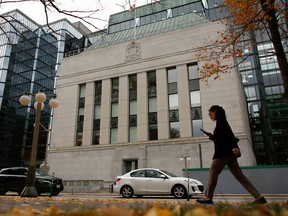Article content
Those looking for a reason why headline wage growth has remained persistently high despite the slowdown in inflation need look no further than the federal government, according to an analysis published this week by Desjardins Group.
Average hourly compensation increased by 5.1 per cent year-over-year in May, compared to a 4.7 per cent increase in April, according to the most recent reading from Statistics Canada.
Article content
But while business sector wage growth has cooled, wage gains for public sector employees remain at elevated levels. In the first quarter of this year, business sector wage growth increased by 3.4 per cent and non-business sector wage growth increased by 8.4 per cent, according to productivity accounts data. While the report notes the latter increase marks a deceleration from the final quarter of 2023, when non-business sector wages rose by 10 per cent, it remains high.
Randall Bartlett, senior director of Canadian economics at Desjardins and author of the report, said he believes a hiring spree and rising wages in the federal public service are driving overall wage growth in Canada.
Employment in the federal public sector has increased by 657,000 workers since 2019, a 17 per cent increase. The private sector, meanwhile, experienced an increase of 662,000 positions, or four per cent, in the same period.
The report notes that at the end of 2019, there were four private sector workers for every public sector worker, now but now that ratio is down to 3.5 to one.
“The level of compensation and extent of hiring we’re seeing at the federal level, I think does lead to distortions,” Bartlett said.
Article content
“It becomes a lot more favourable to work for the federal public service than it does in the private sector or the public service for municipal and provincial governments.”
Federal public servants are among the highest paid in Canada. Compared to 16 other industries, only employees working in the oil and gas sector make more in average hourly earnings.
In particular, those who work in public administration at the federal level between January to May of this year, earned on average $45 an hour, above the overall public and private average of $35 an hour.
Recommended from Editorial
-
What the jobs bonanza means for the Bank of Canada
-

The real story about Canada’s job market before the data drops
The Bank of Canada does look at wage growth as a factor in its inflation outlook, but is more concerned with the private sector, which can pass costs along to consumers directly.
“It really doesn’t feed through as directly as it would for private sector wages, which is much more correlated with the business cycle,” Bartlett said. “If anything, it’s somewhat of a nuisance, in that it is keeping headline wage growth higher than would otherwise be the case, but it certainly not indicative of broad-based inflation or economic conditions that are going to lead to more inflation down the road.”
• Email: jgowling@nationalpost.com
Bookmark our website and support our journalism: Don’t miss the business news you need to know — add financialpost.com to your bookmarks and sign up for our newsletters here.
Share this article in your social network
Canada’s public sector is driving wage growth: Desjardins report
2024-07-04 17:42:56






